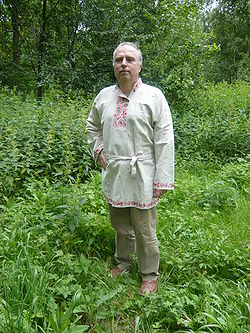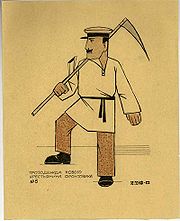
Kosovorotka
Encyclopedia
A kosovorotka is a Russia
n, skewed-collared shirt
. The word is derived from koso - askew, and vorot collar.
 A kosovorotka is a traditional Russian shirt, long sleeved and reaching down to the mid-thigh. The shirt is not buttoned all the way down to the hem, but has several buttons at the collar (unfastened when the garment is pulled over the wearer's head), though these are positioned off to one side (regional styles vary between left and right), instead of centrally, as is customary with a typical Western 20th and 21st century man's shirt. If left unbuttoned the collar appears skewed, which accounts for the garment's name. The collar and sleeves of kosovorotka were often decorated with a traditional Slavic ornament.
A kosovorotka is a traditional Russian shirt, long sleeved and reaching down to the mid-thigh. The shirt is not buttoned all the way down to the hem, but has several buttons at the collar (unfastened when the garment is pulled over the wearer's head), though these are positioned off to one side (regional styles vary between left and right), instead of centrally, as is customary with a typical Western 20th and 21st century man's shirt. If left unbuttoned the collar appears skewed, which accounts for the garment's name. The collar and sleeves of kosovorotka were often decorated with a traditional Slavic ornament.
Today kosovorotka are perceived mostly as men's shirts. However, the shirts for women and children are not too much different from the men's variant, and the word kosovorotka in fact is often used to denote just any kind of shirt. The men's garment was worn loose and was not tucked into the trousers, but instead belted either with a conventional belt, a rope, or a rope-like tie. The tails of the garment hung over the trousers. Women's shirts were tucked into the skirt or worn under the sarafan
, and indeed tended to have a straighter collar. Children's shirts were often too long for those who wore them, and was the only piece of clothing on little boys and girls in the ancient times.
 Generally associated with Russian peasants, the kosovorotka was worn by peasants and townsmen of various social categories into the early 20th century, when it was rapidly displaced as an everyday garment by more efficient and less elaborate clothing after the Bolshevik Revolution of 1917. The garment is also known as a tolstovka, or the Tolstoy-shirt, because the writer Count Leo Tolstoy
Generally associated with Russian peasants, the kosovorotka was worn by peasants and townsmen of various social categories into the early 20th century, when it was rapidly displaced as an everyday garment by more efficient and less elaborate clothing after the Bolshevik Revolution of 1917. The garment is also known as a tolstovka, or the Tolstoy-shirt, because the writer Count Leo Tolstoy
customarily wore one in his later years. Since the late 20th century kosovorotkas appear mostly as souvenirs and as scenic garments of Russian folk music, song and dance
ensembles. The kosovorotka is also seen worn by Omar Sharif
as Yuri Zhivago in David Lean
's 1965 film Doctor Zhivago.
Russia
Russia or , officially known as both Russia and the Russian Federation , is a country in northern Eurasia. It is a federal semi-presidential republic, comprising 83 federal subjects...
n, skewed-collared shirt
Shirt
A shirt is a cloth garment for the upper body. Originally an undergarment worn exclusively by men, it has become, in American English, a catch-all term for almost any garment other than outerwear such as sweaters, coats, jackets, or undergarments such as bras, vests or base layers...
. The word is derived from koso - askew, and vorot collar.
Description

Today kosovorotka are perceived mostly as men's shirts. However, the shirts for women and children are not too much different from the men's variant, and the word kosovorotka in fact is often used to denote just any kind of shirt. The men's garment was worn loose and was not tucked into the trousers, but instead belted either with a conventional belt, a rope, or a rope-like tie. The tails of the garment hung over the trousers. Women's shirts were tucked into the skirt or worn under the sarafan
Sarafan
A Sarafan is a traditional Russian long, shapeless jumper dress worn as Russian folk costume by women and girls.Chronicles first mention it under the year 1376, and since that time it was worn well until the 20th century. It is now worn as folk costume for performing Russian folk songs and folk...
, and indeed tended to have a straighter collar. Children's shirts were often too long for those who wore them, and was the only piece of clothing on little boys and girls in the ancient times.

Leo Tolstoy
Lev Nikolayevich Tolstoy was a Russian writer who primarily wrote novels and short stories. Later in life, he also wrote plays and essays. His two most famous works, the novels War and Peace and Anna Karenina, are acknowledged as two of the greatest novels of all time and a pinnacle of realist...
customarily wore one in his later years. Since the late 20th century kosovorotkas appear mostly as souvenirs and as scenic garments of Russian folk music, song and dance
Folk art
Folk art encompasses art produced from an indigenous culture or by peasants or other laboring tradespeople. In contrast to fine art, folk art is primarily utilitarian and decorative rather than purely aesthetic....
ensembles. The kosovorotka is also seen worn by Omar Sharif
Omar Sharif
Omar Sharif is an Egyptian actor who has starred in Hollywood films including Lawrence of Arabia, Doctor Zhivago and Funny Girl. He has been nominated for an Academy Award and has won two Golden Globe Awards.-Early life:...
as Yuri Zhivago in David Lean
David Lean
Sir David Lean CBE was an English film director, producer, screenwriter, and editor best remembered for big-screen epics such as The Bridge on the River Kwai , Lawrence of Arabia ,...
's 1965 film Doctor Zhivago.

